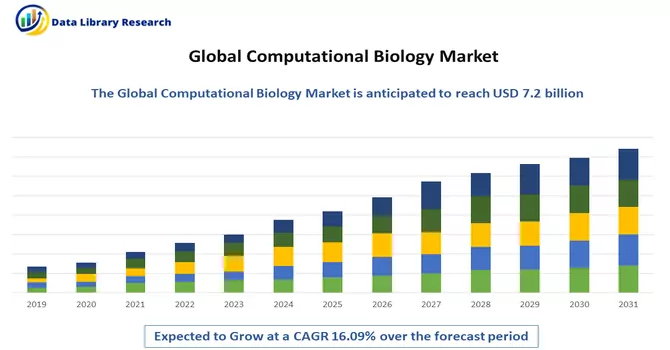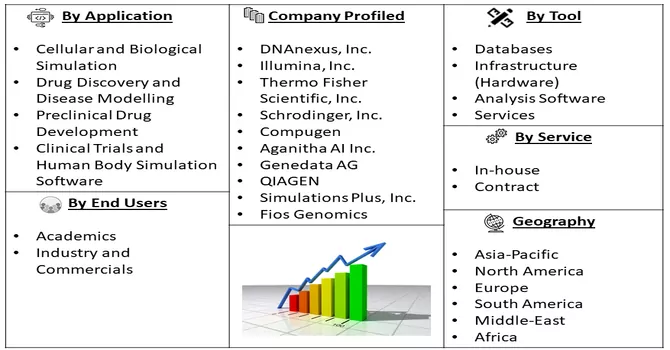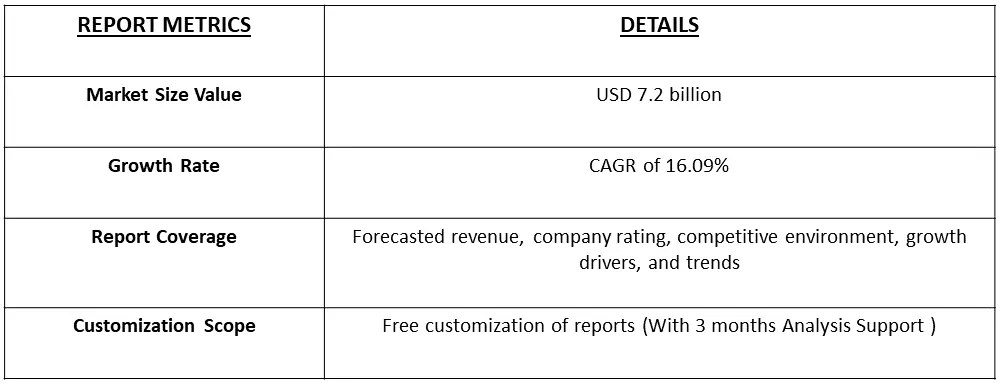The anticipated trajectory of the Global Computational Biology Market indicates a substantial growth from USD 7.2 billion in 2022, reflecting a noteworthy Compound Annual Growth Rate (CAGR) of 16.09% over the forecast period spanning 2023 to 2031.

Get Complete Analysis Of The Report - Download Free Sample PDF
Computational biology is an interdisciplinary field that utilizes computational techniques, algorithms, and mathematical models to analyze biological data, simulate biological processes, and gain insights into the structure and functioning of biological systems. It involves the application of computational methods to solve complex biological problems, understand biological phenomena, and interpret large-scale biological data sets, such as those generated through genomics, proteomics, and other high-throughput technologies. In computational biology, researchers often use computer-based tools and methodologies to analyze biological sequences (such as DNA, RNA, and protein sequences), predict protein structures, simulate molecular interactions, model biological pathways, and analyze large-scale genomic data. The integration of computational approaches with experimental techniques has become increasingly important in advancing our understanding of biological processes and in applications ranging from drug discovery and personalized medicine to systems biology and bioinformatics.
This expansion is primarily attributed to the escalating advancements in genomics and bioinformatics, a surging demand for personalized medicine, as well as increased activity in drug discovery and development. The life sciences sector's imperative for efficient data analysis further propels the market for computational biology. Moreover, the growing integration of artificial intelligence and machine learning in computational biology is poised to provide an additional impetus to market growth.
Market Segmentation: The Computational Biology Market is segmented by Application (Cellular and Biological Simulation, Drug Discovery and Disease Modelling, Preclinical Drug Development, Clinical Trials and Human Body Simulation Software), Tool (Databases, Infrastructure (Hardware), Analysis Software and Services), Service (In-house and Contract), End User (Academics and Industry and Commercials) and Geography (North America, Europe, Asia-Pacific, Middle East and Africa, and South America). The report offers the value (in USD) for the above segments.

For Detailed Market Segmentation - Download Free Sample PDF
The ongoing advancements in genomics and bioinformatics continue to drive the computational biology market. The ability to analyze vast amounts of genomic data has become crucial in understanding genetic variations, disease mechanisms, and potential therapeutic targets. Moreover, the growing demand for personalized medicine is a key trend influencing the computational biology market. Computational biology plays a pivotal role in analyzing individual genetic information to tailor medical treatments, enabling more effective and targeted healthcare interventions.
Market Drivers :
Increase in Bioinformatics Research and Increasing Number of Clinical Studies in Pharmacogenomics and Pharmacokinetics
Bioinformatics research has seen a notable surge, especially in pharmacogenomics, pharmacokinetics, and computational biology. Clinical studies in these fields have significantly increased, showcasing a commitment to leveraging advanced computational techniques for pharmaceutical and medical progress. In pharmacogenomics, there's a heightened focus on understanding how individual genetic variations impact responses to drugs. This has led to increased bioinformatics research, deciphering the complex interplay between genetic factors and drug effectiveness or adverse reactions. The growing number of clinical studies highlights the industry's dedication to tailoring drug treatments based on an individual's genetic makeup, ushering in a new era of personalized medicine. Similarly, in pharmacokinetics, computational biology has become indispensable for unravelling the complexities of drug absorption, distribution, metabolism, and excretion. The rising number of clinical studies in this area reflects a concerted effort to optimize drug dosages and enhance therapeutic outcomes through a deeper understanding of molecular-level drug interactions within the body. The convergence of bioinformatics, pharmacogenomics, and pharmacokinetics is reshaping drug discovery and development. Also, as reported in a news article from January 2023, the average cost of drug discovery and development is approximately USD 1.3 billion. This substantial expense presents a notable opportunity for the integration of AI-based technology in the drug discovery process. Thus, such instances are expected to drive the growth of the studied market over the forecast period.
Growth of Drug Designing and Disease Modelling
Disease modelling has also benefited immensely from computational biology. By integrating vast biological datasets and employing computational models, researchers can simulate and understand the complex dynamics of diseases at a molecular and systemic level. This enables the identification of key disease pathways, potential biomarkers, and the development of targeted interventions. For instance, an article published by NCBI in July 2023, reported that the use of computational biology has brought about a paradigm shift in precision medicine, allowing for the customization of treatments based on individual genetic and molecular profiles. This personalized approach enhances the effectiveness of therapies and minimizes adverse effects, marking a significant advancement in patient care.
Similarly, in February 2023, Accenture made a strategic investment in Ocean Genomics, a U.S.-based technology and AI company specializing in advanced computational platforms. This investment is poised to support biotechnology firms in their endeavours related to the discovery and development of personalized medicines. The proactive involvement of organizations in such strategic initiatives is foreseen as a driving force behind the anticipated growth of the market in the forecast period.
Market Restraints:
Lack of Trained Professionals
The growth of the computational biology market is facing a challenge due to a shortage of trained professionals. There's a lack of individuals with the necessary expertise in both biology and computational sciences, which is slowing down the market's expansion. The intricate nature of computational biology tasks requires a specific skill set, and the current shortage of qualified professionals is holding back the market's full potential. It's essential to address this skill gap to unlock the true growth opportunities in the field of computational biology.
The COVID-19 pandemic had a big impact on the computational biology field. Aside from helping to quickly understand the virus's genetic code and protein structure, computational biology played a crucial role in studying different aspects of the SARS-CoV-2 virus, such as its variations and mutations. It also proved valuable in researching the virus's origin, its hosts, and how it evolved over time. Computational biology wasn't just limited to genomics; it also became a key player in the search for evidence about where the virus came from and how it changed over time. Various computational methods, like molecular docking, molecular dynamics simulation, and artificial intelligence (AI), were essential in speeding up the search for new drugs to treat COVID-19. For example, the ARTIC network, known for its expertise in sequencing outbreaks like Zika and Ebola, optimized a method called SARS-CoV-2 nanopore sequencing. This method helped create accurate genetic sequences of the virus, allowing scientists to track how COVID-19 spread and changed. Thus, the increased attention on computational biology during the pandemic led to more research and advancements. This, in turn, contributed to the overall growth of the computational biology market. This trend is expected to continue, driving further progress in the field in the coming years.
Segmental Analysis:
Cellular and Biological Simulation Segment is Expected to Witness Significant Growth Over the Forecast Period
Cellular and biological simulation within the realm of computational biology has emerged as a powerful tool, facilitating a deeper understanding of complex biological processes. Through sophisticated computational models, scientists can simulate and analyze the dynamic behaviour of biological systems at the cellular level. This includes intricate processes such as cellular signalling, gene expression, and molecular interactions. These simulations provide invaluable insights into the mechanisms governing cellular functions, enabling researchers to explore various scenarios and predict outcomes under different conditions. By leveraging computational approaches, scientists can unravel the complexities of biological systems, gaining a more comprehensive understanding of diseases, drug interactions, and the effects of genetic variations. Thus, computational biology continues to evolve, and cellular and biological simulations will likely play an increasingly vital role in shaping our understanding of life sciences. The integration of advanced computational techniques with biological simulations holds the promise of transformative breakthroughs in medical research, disease modelling, and the development of innovative therapeutic strategies.
Databases Segment is Expected to Witness Significant Growth Over the Forecast Period
Databases play a pivotal role in the field of computational biology, serving as repositories for vast amounts of biological information and facilitating the analysis of complex biological data. These databases are crucial for storing and organizing diverse datasets, ranging from genomic sequences and protein structures to experimental results and clinical information. In computational biology, researchers heavily rely on various databases to access curated and annotated biological data. These databases not only store raw data but also provide tools for querying, analyzing, and visualizing the information. Examples of widely used biological databases include GenBank for genetic sequences, Protein Data Bank (PDB) for protein structures, and The Cancer Genome Atlas (TCGA) for cancer genomics data. The integration of databases in computational biology accelerates research by enabling scientists to efficiently retrieve and analyze relevant information. Bioinformatics tools often utilize these databases to perform tasks such as sequence alignment, structural prediction, and pathway analysis. Thus, the segment is expected to witness significant growth over the forecast period.
Commercial Segment is Expected to Witness Significant Growth Over the Forecast Period
Commercial end-users play a significant role in driving the adoption and application of computational biology across various industries. These end users, typically businesses and enterprises, leverage computational biology to address complex challenges in fields such as pharmaceuticals, biotechnology, healthcare, and agribusiness. Commercial entities in the pharmaceutical sector employ computational biology to expedite drug discovery processes. By simulating molecular interactions, predicting drug-target binding, and optimizing chemical structures, companies can identify potential drug candidates more efficiently. Commercial firms specializing in data analytics and consulting provide computational biology services to other industries. They assist in data interpretation, predictive modelling, and decision-making based on biological data. Thus, the segment is expected to witness significant growth over the forecast period.
North America Region is Expected to Witness Significant Growth Over the Forecast Period
North America is currently a major player in the computational biology market and is set to maintain its leadership in the coming years. The region's growth in this field is fueled by increased funding and active involvement from key industry players. The United States, in particular, is making significant strides in promoting computational biology developments. The National Science Foundation (NSF) has allocated funds in its 2022 Budget Request to Congress to support this field. The NSF's commitment to investing in data analytics, computation, artificial intelligence (AI), machine learning, and infrastructure is expected to drive innovation in computational biology.
Collaborative efforts in the era of personalized medicine are also contributing to market growth. Initiatives like the launch of the AI discovery platform Travel by Indivumed GmbH in July 2021 demonstrate the integration of multi-omics data, disease models, and advanced analytics tools. Additionally, the joint research center established in April 2023 by the Icahn School of Medicine at Mount Sinai and Rensselaer Polytechnic Institute focuses on advancing various areas, including drug development and computational neurobiology. These collaborations are anticipated to accelerate the overall growth of the computational biology market in the region. Thus, North America is expected to witness substantial growth in the computational biology market, driven by significant investments in drug development initiatives across the region.

Get Complete Analysis Of The Report - Download Free Sample PDF
The landscape of the computational biology market is characterized by intense competition, and this trend is anticipated to escalate in the coming years. The market is currently populated by major players, and the entry of new participants, along with the expansion efforts of existing ones, is contributing to heightened competitiveness. As technology continues to advance and product innovations become more prevalent, mid-sized and smaller companies are bolstering their market footprint by introducing new products at competitive price points. This dynamic environment underscores the ongoing evolution and diversification within the computational biology market. Some of the key players operating in the global computational biology market include:
Recent Development:
1) In February 2023, the Centre for Development of Advanced Computing (C-DAC) unveiled two crucial software tools designed to advance research in life sciences. One of these tools, the Integrated Computing Environment, stands out as an indigenous cloud-based computational facility for genomics bioinformatics. This innovative system seamlessly integrates ICE-cube, a dedicated hardware infrastructure, and ICE flakes. The primary objective of this software is to securely store and analyze genomics data on a massive scale, ranging from petascale to exascale, providing a robust platform for bioinformatics research.
2) In January 2023, Insilico Medicine, a clinical-stage company specializing in end-to-end artificial intelligence (AI)-driven drug discovery, introduced its 6th generation Intelligent Robotics Lab. This cutting-edge lab is fully automated and powered by AI-driven robotics, aiming to expedite the drug discovery process. The lab performs a range of functions, including target discovery, compound screening, precision medicine development, and translational research. The integration of AI in this robotics laboratory underscores Insilico Medicine's commitment to leveraging advanced technologies for efficient and innovative drug discovery.
Q1. What was the Computational Biology Market size in 2022?
As per Data Library Research the Global Computational Biology Market indicates a substantial growth from USD 7.2 billion in 2022.
Q2. At what CAGR is the Computational Biology market projected to grow within the forecast period?
Computational Biology Market is reflecting a noteworthy Compound Annual Growth Rate (CAGR) of 16.09% over the forecast period.
Q3. What are the factors driving the Computational Biology market?
Increase in Bioinformatics Research and Increasing Number of Clinical Studies in Pharmacogenomics and Pharmacokinetics and Growth of Drug Designing and Disease Modelling are the factors driving the Computational Biology market.
Q4. What are the factors on which the Computational Biology market research is based on?
By Application, By Tools, By Services, End-User and Geography are the factors on which the Computational Biology market research is based.
Data Library Research are conducted by industry experts who offer insight on industry structure, market segmentations technology assessment and competitive landscape (CL), and penetration, as well as on emerging trends. Their analysis is based on primary interviews (~ 80%) and secondary research (~ 20%) as well as years of professional expertise in their respective industries. Adding to this, by analysing historical trends and current market positions, our analysts predict where the market will be headed for the next five years. Furthermore, the varying trends of segment & categories geographically presented are also studied and the estimated based on the primary & secondary research.
In this particular report from the supply side Data Library Research has conducted primary surveys (interviews) with the key level executives (VP, CEO’s, Marketing Director, Business Development Manager and SOFT) of the companies that active & prominent as well as the midsized organization
FIGURE 1: DLR RESEARH PROCESS

Extensive primary research was conducted to gain a deeper insight of the market and industry performance. The analysis is based on both primary and secondary research as well as years of professional expertise in the respective industries.
In addition to analysing current and historical trends, our analysts predict where the market is headed over the next five years.
It varies by segment for these categories geographically presented in the list of market tables. Speaking about this particular report we have conducted primary surveys (interviews) with the key level executives (VP, CEO’s, Marketing Director, Business Development Manager and many more) of the major players active in the market.
Secondary ResearchSecondary research was mainly used to collect and identify information useful for the extensive, technical, market-oriented, and Friend’s study of the Global Extra Neutral Alcohol. It was also used to obtain key information about major players, market classification and segmentation according to the industry trends, geographical markets, and developments related to the market and technology perspectives. For this study, analysts have gathered information from various credible sources, such as annual reports, sec filings, journals, white papers, SOFT presentations, and company web sites.
Market Size EstimationBoth, top-down and bottom-up approaches were used to estimate and validate the size of the Global market and to estimate the size of various other dependent submarkets in the overall Extra Neutral Alcohol. The key players in the market were identified through secondary research and their market contributions in the respective geographies were determined through primary and secondary research.
Forecast Model
